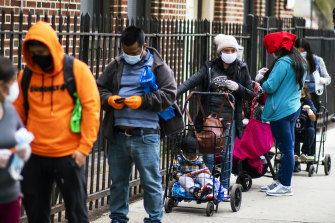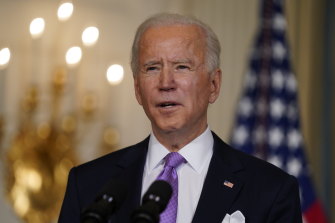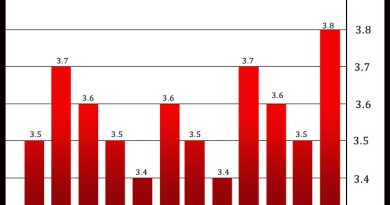The US economy records worst year since end of WWII
Stuck in the grip of a viral pandemic, the US economy grew at a 4 per cent annual rate in the final three months of 2020 and shrank last year by the largest amount in 74 years.
For 2020 as a whole, a year when the coronavirus inflicted the worst economic freeze since the end of World War II, the economy contracted 3.5 per cent and clouded the outlook for the coming year. The economic damage followed the eruption of the pandemic 10 months ago and the deep recession it triggered, with tens of millions of Americans left jobless.
The US economic outlook for 2021 remains hazyCredit:Getty
Thursday’s report from the government estimated that the nation’s gross domestic product — its total output of goods and services — slowed sharply in the October-December quarter from a record 33.4 per cent surge in the July-September quarter. That gain had followed a record-shattering 31.4 per cent annual plunge in the April-June quarter, when the economy sank into a free-fall.
The outlook for 2021 remains hazy. Economists warn that a sustained recovery won’t likely take hold until vaccines are distributed and administered nationwide and government-enacted rescue aid spreads through the economy — a process likely to take months. In the meantime, millions of Americans continue to struggle.
On Thursday, for example, the government reported that while applications for unemployment benefits declined last week, they remained at a historically high 847,000, evidence that companies keep cutting jobs as the pandemic continues to rage. Before the virus erupted in the United States in March, weekly applications for jobless aid had never topped 700,000, even during the Great Recession.
Even as the economy shrank last year, the stockmarket managed to rise sharply, with the S&P 500 index gaining 16 per cent. The disparity between the two reflected a time-tested adage: The stockmarket is a forward-looking indicator, with investors focused on prospects for future corporate profits and economic health rather than on the current state of the economy. So even as the economy was sinking last year, investors looked ahead to hopes for vaccines and government aid and to solid company profits, especially among tech companies, which drove last year’s gains.
The pandemic’s blow to the economy early last spring ended the longest US economic expansion on record — nearly 11 years. The damage from the virus caused GDP to contract at a 5 per cent annual rate in last year’s January-March quarter. Since then, thousands of businesses have closed, nearly 10 million people remain out of work and more than 400,000 Americans have died from the virus.
The government’s report on Thursday was its first of three estimates of growth last quarter; the figure will be revised twice in the coming weeks. The report showed that consumer spending, which accounts for about 70 per cent of the economy, slowed sharply last quarter to a 2.5 per cent annual gain from a 41 per cent surge in the July-September quarter.
Last quarter’s economy was instead driven in part by business investment and housing, which has been a star performer during the past year, reflecting record-low mortgage rates and a demand for more household space. Housing grew at a sizzling 33.5 per cent annual rate, business investment at a 13.8 per cent rate. Government spending, though, shrank at a 1.2 per cent rate last quarter. State and local governments have started to resort to layoffs in response to falling tax revenue.
The estimated drop in GDP for 2020 was the first such decline since a 2.5 per cent fall in 2009, during the recession that followed the 2008 financial crisis. That was the deepest annual setback since the economy shrank 11.6 per cent in 1946, when the economy was demobilising after World War II.
The GDP report showed that former President Donald Trump ended his presidency with GDP averaging annual gains of 1 per cent during his four years. That was lower than the 1.6 per cent annual GDP gains during the Obama administration, a period that also included a recession.
In the coming months, as vaccines become widely distributed and administered, growth is expected to revive. But until then, many Americans will struggle as consumers and businesses hunker down and hold back on spending even though the economy will likely keep growing. Gregory Daco, chief economist at Oxford Economics, said he expects growth to weaken in the current quarter to a roughly 2 per cent annual rate.
But Daco foresees a brightening outlook for the rest of this year. His view assumes a widespread use of vaccines, increased government aid from Congress’ approval of at least part of President Joe Biden’s $US1.9 trillion ($2.5 trillion) relief package and pent-up spending from a savings buildup among higher-income families during the pandemic. A $US900 billion rescue aid package that the government enacted late last year is also providing some support.
President Biden has proposed a $US1.9 trillion rescue package.Credit:AP
“The vaccine rollout is essential,” Daco said. “Without an improving health situation, we are not going to get any improvement in the economic situation.“
Daco said he thinks an economic rebound will produce annual growth this year of 5 per cent. Earlier this week, the International Monetary Fund forecast that the US economy will grow 5.1 per cent this year and 2.5 per cent in 2022.
On Wednesday, the Federal Reserve took note of the economic threats. It kept its benchmark interest rate at a record low near zero and stressed that it would keep pursuing its low-rate policies until a recovery is well underway. The Fed acknowledged that the economy has faltered in recent months, with hiring weakening especially in industries affected by the raging pandemic, notably restaurants, bars, hotels and others involved in face-to-face public contact.
Hiring in the United States has slowed for six straight months, and employers shed jobs in December for the first time since April. The job market has sputtered as the pandemic and colder weather have discouraged Americans from traveling, shopping, dining out or visiting entertainment venues. Retail sales have declined for three straight months.
Mark Zandi, chief economist at Moody’s Analytics, predicts that about 5 million lost US jobs will never return, forcing the unemployed in such industries as restaurants and bars to find work in other sectors.
And many economists warn that without further government financial support, the economy risks succumbing to another recession. They note that much of the aid for individuals from the $US900 billion package that was enacted late last year is set to expire in mid-March.
AP
Business Briefing
Start the day with major stories, exclusive coverage and expert opinion from our leading business journalists delivered to your inbox. Sign up for the Herald‘s here and The Age‘s here.
Most Viewed in Business
Source: Read Full Article



